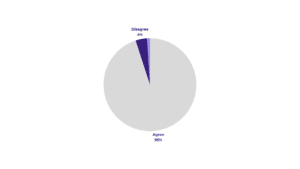Connecticut’s Governor Ned Lamont has a bold vision for the long-term success of his state: He wants to make Connecticut the most family-friendly state in the nation. And he and other state leaders are grounding that vision with a forward-leaning investment in early childhood. Under the leadership of Beth Bye, Commissioner for the Connecticut Office of Early Childhood (OEC), they are going deep and wide in building a strong early childhood system because they believe that being family-friendly is a pragmatic, economic decision essential to secure the state’s future.
I am impressed with the comprehensive approach Governor Lamont and Commissioner Bye are taking to design their early childhood strategy, and think it is worth shining a spotlight on it for other states to consider.
Last month I was honored to join a convening of Connecticut’s government and advisory leaders, policymakers, and early childhood experts to participate in a panel discussion, “Shaping Connecticut’s Tomorrow: A Conversation with Early Childhood Leaders,” alongside Ellen Galinsky, President of Family and Work Institute, Michelle Kang, CEO of NAEYC, and Commissioner Bye.
When Connecticut’s leaders talk, I hear three themes that I think will ensure their success:
- Align your leaders and your resources
- Don’t play favorites: invest in all the essentials for a strong system
- Plan for multi-generational success
Align your leaders and your resources
Connecticut created a shared understanding and alignment around early childhood for the state’s governance bodies through its Blue Ribbon Panel Report. Connecticut is fortunate to have multiple entities, beyond the OEC, that provided guidance and input into the design of a system that will transform early childhood care and education. Together they co-created and committed to a plan featuring common priorities:
- Workforce and Quality
- Equity and Access
- Systems Building and Funding and Costs
I recall a conversation I had with Commissioner Bye several years ago about ways states could address the entire early learning system by taking an approach that better aligns all its resources. The Blue Ribbon Panel Report maps smart resource alignment and allocation to achieve shared goals – for example, providing stable housing for families in addition to high quality early childhood education, and health screenings to address the needs of the whole child. Additionally, as Connecticut strengthens their focus on Birth through Age 3, they are comprehensively approaching the infant/toddler funding challenge by blending and braiding federal and state funds to remove some of the burden on programs.
Don’t play favorites: invest in all the essentials for a strong system
Connecticut’s holistic approach to addressing early childcare and education is comprehensive and thoughtfully weaves together all the elements necessary for a high-quality, equitable early childhood system. Too often states invest unevenly, which diminishes (and sometimes undermines) their overall impact.
The Blue Ribbon plan prioritizes equity for the families with the greatest needs, prioritizes the success of the early childhood workforce, and focuses on stabilization and system building.
I want to particularly call other states’ attention to Connecticut’s focus on the early childhood workforce. The Connecticut plan highlights the importance of providing high quality professional learning for teachers, including career pathways for ECE professionals to get their credentials and increase their knowledge so that they are eligible to receive higher wages. We know that quality professional learning can provide powerful and rich onboarding to staff new to the field and improve the work environment to create a culture that is inclusive and supportive and fosters ongoing learning. As a field, we want to develop professionals’ skills, knowledge, effectiveness, and confidence to increase retention and wellbeing. And Connecticut is showing us how.
Plan for multi-generational success
Family voice is evident throughout Connecticut’s plan and early actions. From philosophically focusing on parents as their child’s first teacher to engaging with parents as thought partners in the convening I attended, Connecticut shows a commitment to thinking about the success of young children through the lens of the whole family. They encourage and prepare families to use their voices to advocate for the needs of their young children now, through their elementary years, and beyond. For the Governor’s “most family-friendly state” vision to be achieved, this is essential.
The early childhood ecosystem must include fully funding early learning and care, as we cannot provide high quality childcare on the back of parents. Connecticut understands that in order to do so, the state will need to provide equitable community and policy supports for parental leave, childcare subsidies, affordable housing and health care screening so that opportunity gaps are addressed. These investments in families create intergenerational benefits that will have a wide-reaching and lasting impact, from the socioeconomic success of individual households to the growth of the entire state’s economy.
Frederick Douglas said, “It’s easier to build strong children than to repair broken men.” I am heartened to see Connecticut carry out his words through policy and planning that invests in the early years. A family-friendly state indeed; let’s all pay attention to Connecticut’s next steps together. This is a model worth watching.

